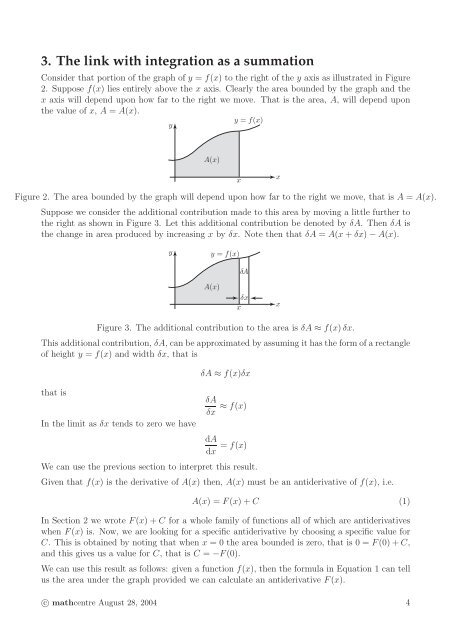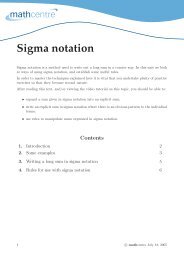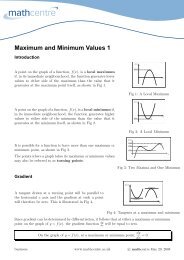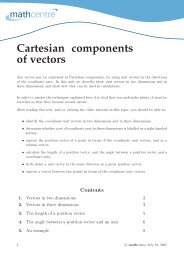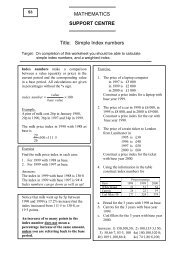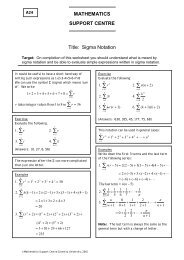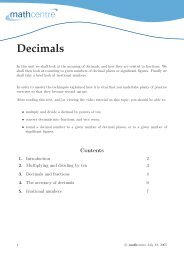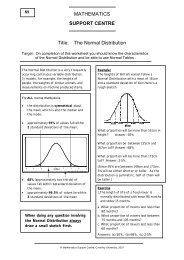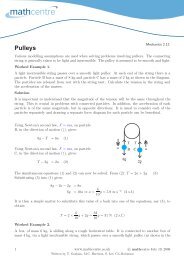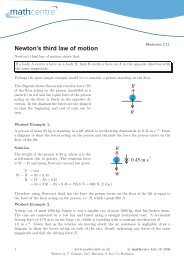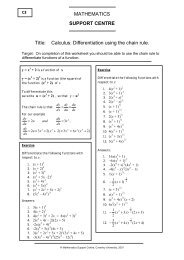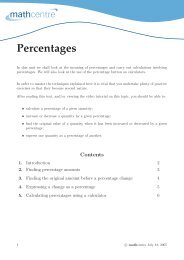indefinite integration as the reverse of differentiation
indefinite integration as the reverse of differentiation
indefinite integration as the reverse of differentiation
Create successful ePaper yourself
Turn your PDF publications into a flip-book with our unique Google optimized e-Paper software.
3. The link with <strong>integration</strong> <strong>as</strong> a summation<br />
Consider that portion <strong>of</strong> <strong>the</strong> graph <strong>of</strong> y = f(x) to <strong>the</strong> right <strong>of</strong> <strong>the</strong> y axis <strong>as</strong> illustrated in Figure<br />
2. Suppose f(x) lies entirely above <strong>the</strong> x axis. Clearly <strong>the</strong> area bounded by <strong>the</strong> graph and <strong>the</strong><br />
x axis will depend upon how far to <strong>the</strong> right we move. That is <strong>the</strong> area, A, will depend upon<br />
<strong>the</strong> value <strong>of</strong> x, A = A(x).<br />
y = f(x)<br />
y<br />
A(x)<br />
x<br />
x<br />
Figure 2. The area bounded by <strong>the</strong> graph will depend upon how far to <strong>the</strong> right we move, that is A = A(x).<br />
Suppose we consider <strong>the</strong> additional contribution made to this area by moving a little fur<strong>the</strong>r to<br />
<strong>the</strong> right <strong>as</strong> shown in Figure 3. Let this additional contribution be denoted by δA. Then δA is<br />
<strong>the</strong> change in area produced by incre<strong>as</strong>ing x by δx. Note <strong>the</strong>n that δA = A(x + δx) − A(x).<br />
y<br />
y = f(x)<br />
A(x)<br />
δA<br />
δx<br />
x<br />
x<br />
Figure 3. The additional contribution to <strong>the</strong> area is δA ≈ f(x) δx.<br />
This additional contribution, δA, can be approximated by <strong>as</strong>suming it h<strong>as</strong> <strong>the</strong> form <strong>of</strong> a rectangle<br />
<strong>of</strong> height y = f(x) and width δx, that is<br />
that is<br />
In <strong>the</strong> limit <strong>as</strong> δx tends to zero we have<br />
δA ≈ f(x)δx<br />
δA<br />
δx ≈ f(x)<br />
dA<br />
dx = f(x)<br />
We can use <strong>the</strong> previous section to interpret this result.<br />
Given that f(x) is <strong>the</strong> derivative <strong>of</strong> A(x) <strong>the</strong>n, A(x) must be an antiderivative <strong>of</strong> f(x), i.e.<br />
A(x) = F(x) + C (1)<br />
In Section 2 we wrote F(x) + C for a whole family <strong>of</strong> functions all <strong>of</strong> which are antiderivatives<br />
when F(x) is. Now, we are looking for a specific antiderivative by choosing a specific value for<br />
C. This is obtained by noting that when x = 0 <strong>the</strong> area bounded is zero, that is 0 = F(0) + C,<br />
and this gives us a value for C, that is C = −F(0).<br />
We can use this result <strong>as</strong> follows: given a function f(x), <strong>the</strong>n <strong>the</strong> formula in Equation 1 can tell<br />
us <strong>the</strong> area under <strong>the</strong> graph provided we can calculate an antiderivative F(x).<br />
c○ mathcentre August 28, 2004 4


